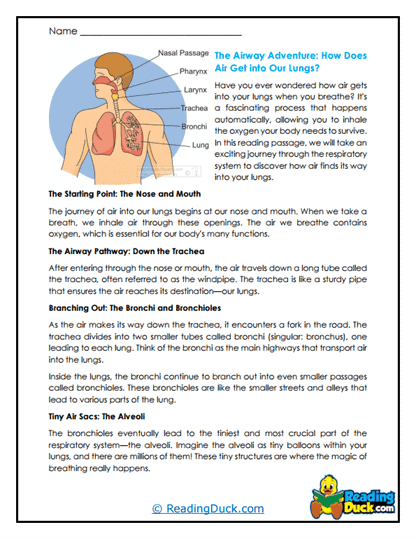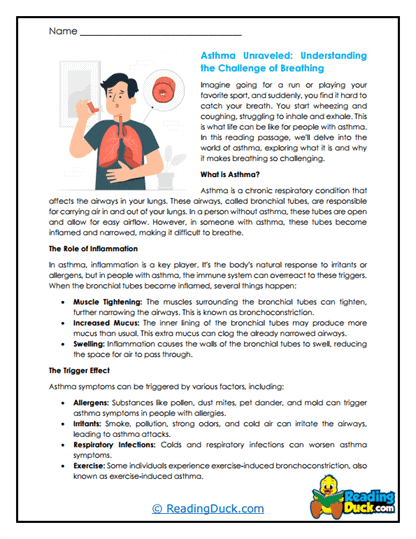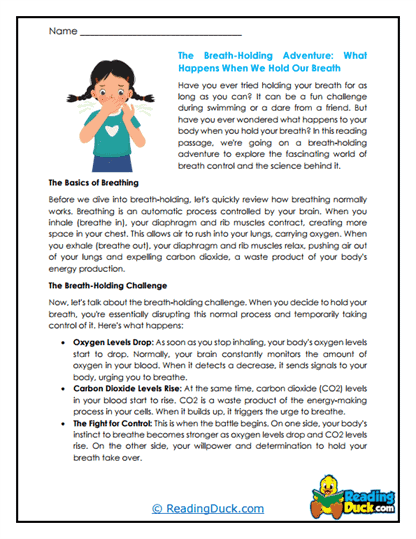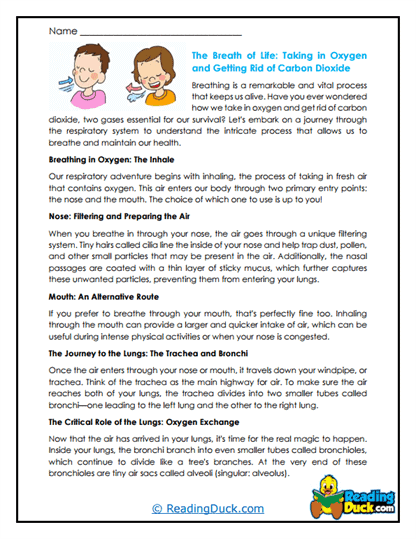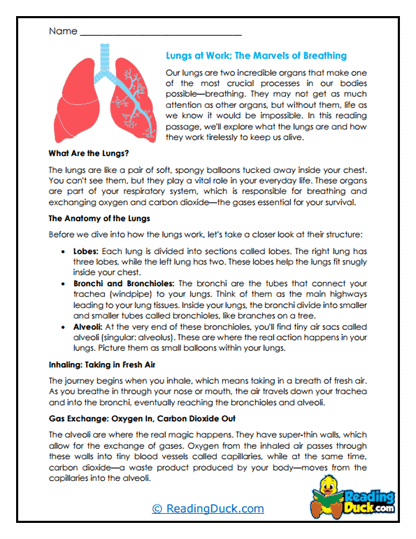Respiratory System Worksheets
About Our Respiratory System Worksheets
Our Respiratory System worksheets provide a thorough and engaging exploration of one of the most vital systems in the human body. As a subtopic under the Human Body category in Science: Biology, this collection delves into the anatomy, function, and importance of the respiratory system. The worksheets are designed to help students understand how the respiratory system supplies oxygen to the body, removes carbon dioxide, and supports overall health. Each worksheet set offers a variety of activities that make learning about the respiratory system both educational and enjoyable.
This collection contains several worksheet sets, each focusing on different aspects of the respiratory system. Each worksheet set includes:
- Multiple Choice Questions: These questions test students' comprehension of the reading material, ensuring they grasp the key concepts and details presented.
- Short Answer Questions: This section prompts students to express their understanding in their own words, reinforcing their knowledge and improving their ability to communicate scientific information effectively.
- Open-Ended Questions: These questions encourage students to share their personal thoughts, opinions, and reflections on the material, fostering deeper engagement and critical thinking.
An answer key is provided for every question sheet, making it easy for educators and parents to review students' work. All worksheets are available in PDF format, ensuring they can be easily viewed electronically, downloaded, and printed for use in various educational settings.
The Respiratory System: Breathing Life Into the Human Body
The respiratory system is essential for life, providing the body with the oxygen it needs to function and removing carbon dioxide, a waste product of metabolism. When introducing students to the respiratory system, it’s crucial to explain how this system works, the structures involved, and its importance in maintaining overall health. Here’s a detailed breakdown of the key components and functions of the respiratory system:
The Pathway of Air: From Nose to Alveoli: The respiratory system starts at the nose and ends at the alveoli, where gas exchange occurs.
- Nasal Cavity and Pharynx: Air enters the respiratory system through the nose, where it is filtered, warmed, and humidified. The nasal cavity contains hairs and mucus that trap dust and pathogens. Students will learn about the pharynx, a shared pathway for air and food, which directs air into the respiratory tract and food into the digestive tract.
- Larynx and Trachea: The larynx, or voice box, is located at the top of the trachea and plays a role in speech production. The trachea, or windpipe, is a tube that carries air from the larynx to the bronchi. Students will explore how the trachea’s cilia and mucus trap and expel foreign particles, keeping the lungs clean.
- Bronchi and Bronchioles: The trachea divides into two bronchi, each leading to a lung. The bronchi further divide into smaller bronchioles, forming a network of airways within the lungs. Understanding this branching structure helps students visualize how air is distributed throughout the lungs.
The Lungs: Gas Exchange and Breathing: The lungs are the primary organs of the respiratory system, where oxygen is absorbed into the blood and carbon dioxide is expelled.
- Alveoli: The alveoli are tiny air sacs at the end of the bronchioles where gas exchange occurs. The walls of the alveoli are extremely thin, allowing oxygen to diffuse into the blood and carbon dioxide to diffuse out. Students will learn how the vast surface area of the alveoli facilitates efficient gas exchange, which is crucial for maintaining oxygen levels in the body.
- Diaphragm and Intercostal Muscles: Breathing is controlled by the diaphragm, a dome-shaped muscle that contracts and flattens during inhalation, creating negative pressure that draws air into the lungs. The intercostal muscles between the ribs also assist in expanding and contracting the chest cavity. Students will explore how these muscles work together to enable breathing.
Respiration: The Process of Breathing and Cellular Respiration: Respiration involves two processes: external respiration (breathing) and internal respiration (cellular respiration).
- External Respiration: This process involves the exchange of gases between the lungs and the blood. Students will learn about the mechanics of breathing, including the roles of the diaphragm, intercostal muscles, and the differences between inhalation and exhalation.
- Internal Respiration: Internal respiration refers to the exchange of gases between the blood and body cells. Oxygen is delivered to cells for cellular respiration, a process that produces energy by breaking down glucose. Carbon dioxide, a byproduct of this process, is transported back to the lungs for exhalation. Understanding internal respiration helps students connect the respiratory system with the body’s energy production.
The Role of the Respiratory System in Maintaining pH Balance: The respiratory system plays a key role in maintaining the body’s pH balance by regulating carbon dioxide levels.
- Carbon Dioxide and pH: Carbon dioxide dissolves in the blood to form carbonic acid, which can lower blood pH. By increasing or decreasing the rate of breathing, the respiratory system can adjust the amount of carbon dioxide expelled, thereby helping to maintain a stable pH. Students will explore how this balance is crucial for normal cellular function and overall health.
- Hyperventilation and Hypoventilation: Hyperventilation (breathing too quickly) can lead to a decrease in carbon dioxide levels, raising blood pH (alkalosis), while hypoventilation (breathing too slowly) can increase carbon dioxide levels, lowering blood pH (acidosis). Understanding these conditions helps students appreciate the importance of proper respiratory function.
Respiratory System Health and Disorders: The respiratory system is susceptible to various disorders that can impact breathing and overall health.
- Asthma: Asthma is a chronic condition characterized by inflammation and narrowing of the airways, leading to difficulty breathing. Students will learn about the triggers, symptoms, and management of asthma, helping them understand how the respiratory system can be affected by environmental and genetic factors.
- Chronic Obstructive Pulmonary Disease (COPD): COPD is a group of lung diseases, including emphysema and chronic bronchitis, that cause obstructed airflow and breathing difficulties. Understanding COPD helps students recognize the long-term impacts of smoking and other risk factors on respiratory health.
- Pneumonia and Infections: Pneumonia is an infection that inflames the air sacs in the lungs, which can fill with fluid or pus, making breathing difficult. Students will explore how bacterial, viral, and fungal infections can affect the respiratory system and the importance of vaccines and proper hygiene in preventing respiratory illnesses.
By studying these aspects of the respiratory system, students gain a comprehensive understanding of how their bodies obtain oxygen, remove carbon dioxide, and maintain overall health. The worksheets help break down complex concepts into engaging and accessible material, fostering curiosity and a deeper appreciation for the respiratory system’s role in sustaining life.
Using These Worksheets In Class
Here are three creative ideas on how teachers and parents can use these Respiratory System worksheets in school or in a homeschool setup:
- Build a Lung Model: Students can create a simple lung model using balloons, straws, and plastic bottles to demonstrate how the diaphragm and lungs work together to enable breathing. Using the worksheets as a guide, they can label the parts of their model and explain the process of inhalation and exhalation. This hands-on activity helps students visualize the mechanics of breathing and reinforces their understanding of the respiratory system.
- Breathing Rate Experiment: Conduct a classroom experiment where students measure their breathing rate at rest and after physical activity. They can record their findings using the worksheets and analyze how physical exertion affects their breathing rate and oxygen demand. This experiment not only reinforces their understanding of the respiratory system but also emphasizes the importance of physical fitness and respiratory health.
- Respiratory System Role-Play: Organize a role-playing activity where students act out the journey of air through the respiratory system, from the nasal cavity to the alveoli. They can demonstrate how oxygen is absorbed into the blood and how carbon dioxide is expelled from the body. The worksheets can provide the scientific background needed for students to accurately depict the respiratory process. This interactive approach makes learning about the respiratory system engaging and memorable.
The Importance of Understanding the Respiratory System
Understanding the respiratory system is crucial for students on both an academic and personal level. Academically, it provides a foundation for advanced studies in biology, health sciences, and medicine. It also enhances critical thinking skills as students explore how the respiratory system interacts with other systems in the body, such as the circulatory and muscular systems.
On a personal level, knowledge of the respiratory system empowers students to make informed decisions about their health and well-being. Understanding how their lungs and airways function helps students appreciate the importance of avoiding harmful habits like smoking, staying active, and protecting themselves from respiratory infections. This awareness can lead to healthier lifestyle choices and a better understanding of how to care for their bodies as they grow and develop.
Overall, these Respiratory System worksheets offer a valuable resource for educators and students alike, providing a detailed and engaging exploration of one of the most essential systems in the human body.
